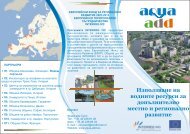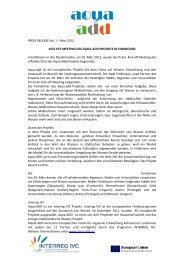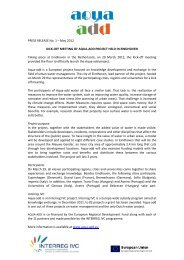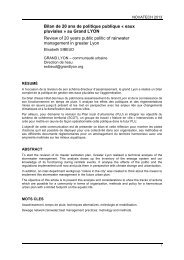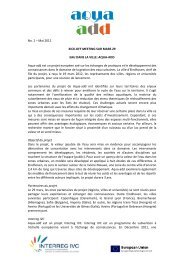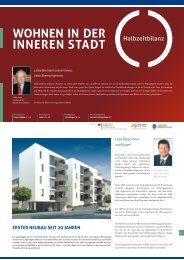COPeNHaGeN ClImate reSIlIeNt NeIGHBOUrHOOd - Klimakvarter.dk
COPeNHaGeN ClImate reSIlIeNt NeIGHBOUrHOOd - Klimakvarter.dk
COPeNHaGeN ClImate reSIlIeNt NeIGHBOUrHOOd - Klimakvarter.dk
Create successful ePaper yourself
Turn your PDF publications into a flip-book with our unique Google optimized e-Paper software.
COPENHAGEN<br />
CLIMATE RESILIENT<br />
NEIGHBOURHOOD<br />
klImakvarter.<strong>dk</strong><br />
1
”In the future we will get more rain, higher sea levels<br />
and warmer weather. This presents Copenhagen with a<br />
number of challenges. We must meet the challenges now.<br />
In St. Kjeld´s Neighbourhood we will work particularly on<br />
adapting to climate change with the use of blue and green<br />
elements in the urban space, which will make Copenhagen<br />
an even greener and more attractive city to live in.”<br />
Ayfer Baykal, Mayor,<br />
The Technical and Environmental Administration,<br />
the City of Copenhagen<br />
<strong>Klimakvarter</strong>.<strong>dk</strong> is a project run by the City of Copenhagen. It is a cooperative venture between the<br />
Park and Nature Department, the Integrated Urban Renewal in St. Kjeld’s, Urban Renewal, HOFOR and<br />
Environmental Centre Østerbro.<br />
All illustrations have been done by the architects<br />
DEN EUROPÆISKE<br />
UNION<br />
Den Europæiske<br />
Fond for<br />
Regionaludvikling<br />
2
copenhagen´s first<br />
climate resilient<br />
neighbourhood<br />
The first climate resilient neighbourhood<br />
Why adapt?<br />
Greener streets and improved urban space<br />
There is room for it<br />
The optimal urban space<br />
Vision for Bryggervangen<br />
Vision for St. Kjeld’s Square<br />
Vision for Tåsinge Square<br />
Green enclosed courtyards<br />
p<br />
p<br />
p<br />
p<br />
p<br />
p<br />
p<br />
p<br />
p<br />
5<br />
7<br />
9<br />
11<br />
13<br />
17<br />
21<br />
25<br />
29<br />
3
4<br />
Vision of St. Kjeld’s Square.
copenhagen<br />
climate resilient<br />
neighbourhood<br />
Greener streets, front gardens in full bloom, abundant wildlife and green<br />
solutions to lead the rainwater away from the neighbourhood.<br />
These are just some of the projects we hope to implement in the St. Kjeld’s<br />
Neighbourhood in Østerbro in the coming years to make the neighbourhood<br />
more resilient against coming climate changes like strong and heavy cloudbursts.<br />
Adapting to climate change and the development of an attractive<br />
and green city will become two sides of the same coin.<br />
In this folder, you can read about the background of the project and see the<br />
proposals for the streets and public spaces in the neighbourhood.<br />
We are looking forward to turning St. Kjeld’s Neighbourhood into the first<br />
neighbourhood in Copenhagen with focus on innovative climate adaptation.<br />
KLIMAKVARTER.DK<br />
5
MAIN WATER CHANNEL<br />
MINOR WATER CHANNEL<br />
POSSIBILITY 1<br />
POSSIBILITY 2<br />
EXIT TO THE HARBOUR A<br />
EXIT TO THE HARBOUR B<br />
WATER CATCHMENT AREA<br />
FOCUS AREA<br />
The water’s way to the harbour. St. Kjeld’s Neighbourhood is located in Østerbro, north of Fælledparken. We will secure an<br />
entire neighbourhood against the effects of torrential rain by creating channels in the streets that will lead large quantities of<br />
water to the harbour where it will do no damage.<br />
6
why adapt?<br />
The climate is changing. We can expect more rain in the future and<br />
cloudbursts such as those Copenhagen has experienced the past two<br />
summers: rain in such large quantities that the sewer system cannot handle<br />
it and our basements are flooded.<br />
Enlarging the sewer system so that it can cope with every possible rain event<br />
will be an expensive solution, which would cause construction works for a<br />
large part of the city for decades without any further benefits.<br />
Instead, in St. Kjeld’s Neighbourhood we want to secure the city against the<br />
heavy rain with green solutions at street level. Solutions that create lush,<br />
beautiful urban spaces while effectively leading water from cloudbursts<br />
away from our neighbourhood to areas where it causes no damage.<br />
Cloudburst solutions can be green streams in the widest streets of the<br />
neighbourhood or it could be new cycle tracks, which can also serve as<br />
channels leading large quantities of water from the neighbourhood to the<br />
harbour when there are no bikes.<br />
At the same time, we will create local solutions such as rain gardens which<br />
can detent water, water towers to store water and greener courtyards that<br />
contribute to retaining the water. This reduces the pressure on the sewer<br />
system from intense daily rain.<br />
7
Bryggervangen<br />
St. Kjeld´s Square<br />
Tåsinge Square<br />
Bryggervangen<br />
8 8
greener streets and<br />
improved urban space<br />
St. Kjeld’s Neighbourhood has been chosen as an exhibition area for<br />
climate adaptation in the City of Copenhagen. There are several reasons<br />
for this particular part of Copenhagen being chosen. One of the most<br />
important is that the neighbourhood has wide streets and a lot of<br />
asphalt.<br />
It is our vision, that 20% of the covered surface area in the neighbourhood<br />
should be turned into green areas and that 30% of the daily rainwater<br />
should be managed locally and not end up in the sewer system. We want<br />
to find the most innovative and effective solutions for climate adaptation<br />
of urban spaces and enclosed courtyards together with the residents of<br />
the neighbourhood.<br />
The project started in 2012, focusing on St. Kjeld’s Square, Tåsinge<br />
Square and Bryggervangen. The goal is to officially open the first squares<br />
in 2015/2016 at an international conference on climate adaptation in<br />
cities. In this way, the climate adaptation solutions can serve as a source<br />
of inspiration for the creation of greener streets and improved urban<br />
space throughout cities around the world.<br />
9
OVERFLADE I DAG<br />
8.000 m2<br />
270.000 sqm<br />
is the road surface area in St.<br />
Kjeld’s Neighbourhood today.<br />
The streets are much wider than<br />
necessary to be able to handle<br />
the local traffic.<br />
270.000m2 50.000m2<br />
OVERFLADE I MORGEN OVERFLADE I DAG<br />
16.500 m2 8.000 m2<br />
50.000 sqm<br />
of green spaces can be created if<br />
we design the streets according<br />
to current standards - with<br />
traffic in both directions and the<br />
same number of parking lots<br />
as today.<br />
270.000m2 50.000m2 220.000m2<br />
x2<br />
Byrumsflade OVERFLADE optimeret I med MORGEN<br />
206% 16.500 m2<br />
Better urban life<br />
In this way we create space for<br />
green corridors, roadside trees,<br />
front gardens and thriving urban<br />
space without losing a single<br />
parking lot.<br />
50.000m2 220.000m2<br />
10<br />
Byrumsflade optim<br />
206%<br />
x
there is room for it<br />
A characteristic of the St. Kjeld’s Neighbourhood is that there is a lot of<br />
asphalt. The streets appear too big in some places, and there are areas<br />
where the broad streets seem empty and unfinished.<br />
The road surface area in the neighbourhood today covers 270,000 sqm.<br />
The roads do not need to be this wide in order to be able to handle local<br />
traffic. By designing the streets in new ways we can liberate an area of<br />
50,000 sqm which can be transformed into thriving urban space with<br />
green streets, front gardens, street trees and rain gardens.<br />
An overall analysis shows that the roads on average can be narrowed by<br />
20% and still meet the required standards. We can therefore reduce the<br />
road surface area by a fifth, and at the same time improve the urban<br />
space for pedestrians and cyclists. This can be done without losing a<br />
single parking lot and buses and cars will have the same access to the<br />
neighbourhood as today.<br />
Asphalt. Bryggervangen at Landskronagade today. From grey surface to green urban space.<br />
11
Bryggervangen at Ourøgade<br />
Today Bryggervangen is a wide street<br />
with parking lots on both sides –<br />
also on the sunny side.<br />
Sun and shadow<br />
The public space can be improved by<br />
concentrating parking in the shadow, along<br />
offices and supermarkets.<br />
Suggestion<br />
This way it is possible to liberate some space<br />
for a green recreational area on the sunny<br />
side of the street where people live without<br />
reducing the number of parking lots.<br />
12 Example of optimal use of street space - Bryggervangen at Ourøgade
the optimal<br />
urban space<br />
The architects TREDJE NATUR have been working on optimizing the design of<br />
St. Kjeld’s Square, Tåsinge Square and Bryggervangen based on an analysis<br />
of the existing urban conditions and potential. It is a complex work, which<br />
contains many layers, including:<br />
Light. Where are the sunny spots and which corners have potential to<br />
become green areas?<br />
Entrances. How can we create meeting places and recreational areas where<br />
there is most activity and people live?<br />
Traffic. Where is the traffic today, and is it possible to narrow down<br />
individual streets and still handle the traffic?<br />
Cables and pipes. The ground contains a maze of sewers, water pipes,<br />
electricity, telephone and computer cables, which can be a challenge for<br />
creating green spaces in some places.<br />
Terrain. Where does the water flow naturally and what size should the<br />
channels and rain gardens be to handle it?<br />
The following diagrams show some of the architects’ preliminary analyses.<br />
The project proposals, which follow, show how we can create a green<br />
neighbourhood with improved urban space and sunny green corners, while<br />
maintaining room for buses, cars and parking.<br />
13
Parking 2012 Parking underground<br />
Parking 2015<br />
Future parking associations<br />
Bike lanes<br />
Entrances<br />
Offices and shops at street level<br />
Underground pipes<br />
Potential project areas<br />
Recidences with lack of<br />
installations<br />
Traffic noise - day<br />
Traffic noise - night<br />
14 preliminary ANALYSES
Dimensions<br />
Hard surfaces 2012 Streets 2012 Streets 2015<br />
Shadow Ownership Sections Building profile<br />
Green elements 2012 Green enclosed courtyards 2012<br />
Potential green facades<br />
Enclosed courtyard entrances<br />
preliminary ANALYSES<br />
15
Bryggervangen today<br />
Bryggervangen at Landskronagade. Improved urban space on Bryggervangen can create local meeting places along the green stream.<br />
16
Bryggervangen<br />
the green stream<br />
The intersection where Bryggervangen meets Landskronagade is a spot that<br />
is characteristic for the St. Kjeld´s Neighbourhood. There is so much asphalt<br />
in this place that many people lose their bearings. To remedy the confusion<br />
of pedestrians, cyclists and motorists a large asphalt area has been painted<br />
with white stripes. The intersection is an obvious place to make a beautiful<br />
green urban space while handling the traffic effectively.<br />
At a stretch of about 500 meters there are office buildings on one side of<br />
Bryggervangen and housing associations on the other side. Today there are<br />
parking on both sides – also on the sunny side.<br />
To create space for a better urban life, parking can be moved to the shady<br />
side and be placed next to the office buildings. This means that the<br />
residents can step straight into a green space when leaving their home.<br />
By designing Bryggervangen this way, we can create a green stream<br />
through the neighbourhood, making the street lush and able to channel the<br />
rainwater to the harbor during a cloudburst. On selected corners the stream<br />
can spread out, for example where Bryggervangen meets Landskronagade<br />
and contribute to a new green space for the residents.<br />
17
St. Kjeld´s Square today<br />
20<br />
St. Kjeld’s Square. The proposal is inspired by the dead ice landscape - a Danish cultural landscape with characteristic depressions<br />
in the surface. Here nature can break through the asphalt.
St. Kjeld´s square<br />
the green heart of<br />
the neighbourhood<br />
Today, St. Kjeld’s Square is a large roundabout. This is where the neighbourhood’s<br />
intersecting roads meet around a group of beautiful old trees. The<br />
street area in the roundabout is 13 meters wide today - three times as wide<br />
as traffic actually requires. This means that many motorists drive too fast,<br />
and the residents are cut off from using the green area in the middle.<br />
The square is the natural centre in the neighbourhood, and St. Kjeld’s<br />
Square can become the green heart of the neighbourhood: an urban space,<br />
where the green elements are allowed to expand, and where there is still<br />
room for traffic. It will become an accessible green landscape where the<br />
sound of splashing water will drown out the traffic noise.<br />
Because of its central location and its vast size - 8000 sqm - St. Kjeld’s<br />
Square has the potential to become a leading example of how we adapt our<br />
urban spaces to climate change in new and innovative ways.<br />
21
22<br />
Illustration: TREDJE NATUR
Tåsinge Square today<br />
Tåsinge Square. From a pointless expanse of asphalt to a refreshing green area.<br />
24
Tåsinge square<br />
local meeting place<br />
and green oasis<br />
Today, Tåsinge Square is an overgrown bunker, rarely used by residents<br />
living around the square. The green area of the bunker is surrounded by<br />
beautiful buildings and sunny most of the day, which is why Tåsinge Square<br />
has a great potential to become a green venue where local cafés and<br />
cultural life can thrive.<br />
Tåsingegade, Ourøgade and Langøgade meet at a large area next to the<br />
bunker, which is a confusing and unsafe spot to navigate in. It is an example<br />
of an asphalt area which not only serves no purpose, but actually disrupts<br />
traffic. By rearranging the traffic flow, we can create a green area of over<br />
1.000 sqm without losing any parking lots.<br />
We can create better conditions for motorists, cyclists and pedestrians by<br />
closing Langøgade where it meets Tåsinge Square and expanding the green<br />
area. In the future the existing shopfront will face the green space, and Tåsinge<br />
Square can be a vibrant and attractive place to meet: an urban space<br />
with ample room for dog walkers, city gardens, benches and children.<br />
25
Large enclosed courtyard<br />
In a large enclosed courtyard, there is room for big trees<br />
without compromising on direct sunlight to the apartments.<br />
The roofs can be greened and hard covered surfaces can be<br />
transformed into water play and detention ponds.<br />
Narrow enclosed courtyard<br />
In a narrow enclosed courtyard, it is natural to adapt the<br />
facades to both climate solutions and energy renewal. Green<br />
and blue facades can be part of a rethinking of dwelling<br />
opportunities and energy reduction. The water can be used<br />
to cool the building and courtyards and to water the green<br />
facades.<br />
28 EXAMPLES OF CLIMATE ADAPTATION IN enclosed COURTYARDs
green enclosed<br />
courtyards<br />
a characteristic of<br />
the neighbourhood<br />
The enclosed courtyards in St. Kjeld´s Neighbourhood are spacious and intimate<br />
at the same time. Many blocks have large green enclosed courtyards<br />
where much of the neighbourhood’s social activities take place. In some<br />
cases, there are also private front gardens on the street side, which create<br />
a safe and welcoming atmosphere. These qualities are something we must<br />
protect and strengthen.<br />
Copenhagen Communal Courtyards will remodel several courtyards in<br />
the neighbourhood over the coming years. In addition to expanding and<br />
improving the courtyards, the goal is to manage daily rainfall locally. Roof<br />
water can be collected in rain gardens, water towers or detention ponds<br />
and used locally for irrigation or play. At the same time, the courtyards will<br />
be designed to channel rainwater from cloudbursts to the street so it does<br />
not end up in the basements.<br />
The enclosed courtyards in St. Kjeld’s Neighbourhood are typical of the<br />
enclosed courtyards to be found in the rest of Copenhagen. With the right<br />
solutions here we can inspire others to remodel their own enclosed<br />
courtyards - and thus ensure that owur city is ready to withstand the<br />
changes that the climate will present us with in the future.<br />
29
Come visit us at Vennemindevej 39,<br />
call us at +45 30 45 48 50<br />
or mail us at info@klimakvarter.<strong>dk</strong>.<br />
Read more about the project, the various events<br />
and your opportunities at WWW.KLIMAKVARTER.DK




